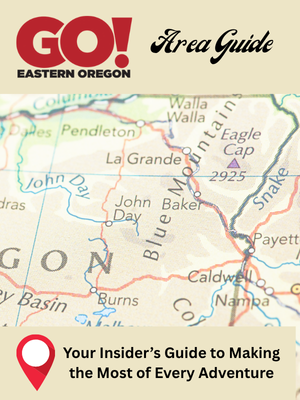COLUMN: An exotic and expensive surprise in the hinterlands
Published 11:30 am Friday, September 29, 2023
The glint of brilliant yellow beside the highway snagged my eye, too bright for even that glowing symbol of late summer, the rabbitbrush in bloom.
This shade, seeming almost to scream, was something only the clever chemists, with their multisyllabic dyes and patented polymers, could concoct.
Nor was it alone.
As we came closer, breezing along at nearly 70 mph, I detected other unnatural hues just beyond the barbed wire fence that paralleled the road.
A feverish red as rich as arterial blood.
A blue that no sky ever was, or should be.
As the distance shrank my understanding grew.
We were seeing a line of cars, parked door to door beside a remote stretch of Highway 395 between John Day and Burns.
(Forgive my indulgence in near redundancy — pretty much any stretch of that highway, the high and lonely two-lane thoroughfare through Eastern Oregon’s vast rangelands and pine forests, could fairly be described as remote.)
I tapped the brakes but did not slow.
My father-in-law, Howard Britton, and I were driving to Burns early on the last afternoon of August to watch my daughter, Olivia, play volleyball.
We had no minutes to spare if we were to see the opening serve.
I had time, though — the highway is straight and was, as it typically is, devoid of other traffic — to recognize several of the cars as Ferraris.
Also one Aston Martin, with its distinctive strip of chrome spanning an opening in the front fender.
And a couple of Porsches.
There were, I judged, maybe 20 cars in all.
Each, so far as I could tell from my brief assessment, was an exotic model of the sort that, at least until recent upheavals in the real estate market, had a sticker price when new that rivaled the figures on many people’s mortgages.
The very antithesis of the car whose primary purpose is to move people and their stuff.
These are rolling sculptures.
Assembled, at least in part, by skilled hands rather than programmed robots.
Vehicles with seats covered in sumptuous leather, with tires as wide as a garbage can lid, with engines that spawn acceleration rapid enough to induce nausea.
Cars capable of bearing bags of groceries but which are rarely engaged for such plebeian tasks. To do so would be akin to employing a Rodin as a doorstop, or draping a fine Persian rug on the front porch, where people can wipe their muddy boots.
It was a strange scene.
Its opposite, I suppose, would be a tractor rumbling down Rodeo Drive, leaving shoppers gasping for air amid oily clouds of diesel exhaust, clutching their Gucci bags as the survivor of a capsizing boat might grasp at a piece of wreckage floating past.
I wouldn’t have been shocked to see a $200,000 machine in the hayfields of the Silvies Ralley Ranch, to be sure.
But I’m thinking of a combine hauling a baler.
Not a piece of automotive art crafted in Modena, Italy, or Stuttgart, Germany.
The cars were parked at the upper end of the Silvies Valley Ranch airstrip.
It required no feat of deductive prowess to connect this collection of rare cars with the ranch.
Although Silvies Valley is a working ranch, with thousands of head of cattle and hay meadows that sprawl across many miles of the valley of the ranch’s namesake river, the property also includes accommodations considerably more opulent than is typical for this country that spans two of Oregon’s least-populated counties, Grant and Harney.
There is a resort with lodging and dining, four golf courses, a spa, a shooting range, mountain bike and ATV trails, fishing, and Scotch and wine tasting.
Which is to say, the sorts of amenities that attract people who drive cars as costly as condominiums.
While we were in Burns, watching spikes and digs, I was regretting that I hadn’t stopped to have a better look at the cars.
(It turns out we could have taken 10 minutes and still been in the bleachers for the start.)
I vowed that if the cars were still parked beside the airstrip on our way home, we’d pull over.
Although dusk was falling as we crossed into Grant County, just a few miles from the airstrip, I could see the bright specks of the cars from better than a mile off.
I turned onto the gravel access road. There was a metal gate about 100 feet ahead, but I saw a man walking near the hangar next to the runway.
I greeted him and he walked over to the fence.
I asked about the cars, and he answered that their owners were staying at the resort and didn’t want to drive any farther on gravel than is necessary.
This seemed sensible to me for models with the approximate ground clearance of a corpulent badger.
I thanked the man, not bothering to inquire about making a closer inspection of what I now counted as 21 cars.
We drove on into the gloaming.
I kept thinking about those cars, and the incongruity of coming across what I suspect was at least $3 million worth of machinery in a place where the diesel pickup truck defines the automotive landscape.
When we crested Dixie Pass the blue moon suddenly appeared, so bright and so rusty red from smoke that I at first took it for flames in distant trees.
I wondered what that row of gleaming cars looked like in that strange light.
And of course I wondered what it would be like to drive any of them, watching the speedometer needle sweep through its arc on the lonely highways of Eastern Oregon and listening to the shriek of the pistons and valves echoing off the rimrock and the roadside junipers.








